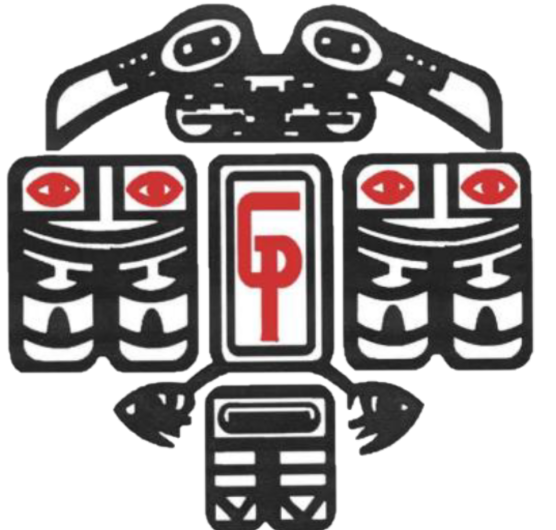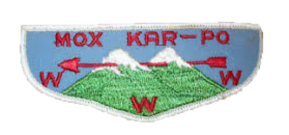Mox Kar-Po (MKP) works closely with Kitsap District to provide cheerful service to the greater communities of Bainbridge Island, Seabeck, Crosby, Bremerton, Silverdale, Port Orchard, Belfair, Erlands Point, Kitsap Lake, Indianola, Kingston, Manchester, Olalla, Parkwood, Poulsbo, Suquamish, and Tracyton
Meeting Location
We meet on the fourth Wednesday of the month (break for July and August) starting at 7 PM at VFW Post #4992 (9981 Central Valley Rd NE, Bremerton, WA 98311). Map Link Here
Leadership
Chapter Chief: Ethan Horowitz
Secretary: Lillian J.
Activities Vice Chief: Jonah C.
Inductions Vice Chief: Adrian T.
Service Vice Chief: Nathan L.
Ceremonies Chair: Ethan Horowitz
Chapter Adviser: Nicholas Horowitz
Associate Advisors:
Ceremonies: Benjamin Le Clair
Inductions: Sam Leckron
If you want to contact someone on this list other than Chief or Advisor, email the Chief and they will direct your message to the appropriate Officer.


History taken from https://www.historylink.org/File/20449 By Fred Poyner IV Posted on 10/09/2017
Camp Parsons on the Olympic Peninsula
Shortly after the the Seattle council received its BSA charter, Ingraham and Parsons turned their attention to securing a permanent camp where Scouts could meet on a regular basis during the summer months. In 1919, the council approved the purchase of 165 acres located at Jackson Cove on Hood Canal near Brinnon in Jefferson County. The new camp was named for Parsons in recognition of his leadership as first president of the Chief Seattle Council, as the council had become known. The purchase cost of $2,200 came from publicly raised funds and was made for the council by the Seattle Trust Company. The first building constructed for the camp, Booth Hall, served as both dining hall and administration office.
The first Boy Scouts arrived at Camp Parsons in June 1919, traveling by ferry to Brinnon, and hiking five miles from the debarking point to the camp. Boats from the Mosquito Fleet — the dozens of steamboats, including the Virginia V, the Concordia, the Monticello, the Fortuna, the Ariel, and more, that provided the primary means of transportation around Western Washington until well into the twentieth century — brought loads of Boy Scouts to Camp Parsons each summer that followed up until 1950.
That first summer of 1919 saw some 100 new Boy Scouts camping on the Camp Parsons waterfront. On August 5, 1919, one of them, Charlie Harris, mailed a postcard to his parents in Seattle, in the earliest known message sent home from the camp: “Dear Folks: I am coming home Tues[day] about 2: o’clock. I am having a fine time. I passed my Second Class examination. Your son, Chas” (Harris).
Given the camp’s location not far from the Olympic Mountains, it is unsurprising that many of the Scouts’ summer hikes in the early years and on into the late 1950s were on the Olympic Peninsula. Indeed, even before Camp Parsons opened, University of Washington history professor Edmond S. Meany (1862-1935) had led one of the first Scouting trips to the peninsula in 1914. An active outdoor enthusiast, Meany would go on to serve as both president (1925) and commissioner (1934) for the Chief Seattle Council. For a few years after Meany’s death, the east side of Camp Parsons was operated from 1938 to 1941 as a Cub Scout camp named in his memory. In 2017, a portrait medallion of the professor still hung in the camp’s dining hall above the fireplace.
Alan Hutchison, curator of the Camp Parsons Museum, described how the Olympic hikes evolved after the camp opened in 1919:
“The Olympic hikes held during the second week of camp … started from the first year. There is a mention that the first director [Harry Cunningham] took a group of Scouts up the Dosewallips the very first year. After that most of the hikes were conducted by older teenagers who were on staff. This continued until 1951 when the council moved to one week sessions. Some troops, including mine would schedule a trip to the Olympics after spending one week at camp. The camp would provide the food if the troop desired or the troop would bring their own” (Hutchison email, September 21, 2017).
Camp Life
Camp life was meant to be an enjoyable experience for the boys, designed to promote Scouting ideals while encouraging participation and recruitment of new members to a troop or den. One of the camp’s early publications, put together by the Scouts in 1925, reported on a couple items that evidently brought many a smile to the faces of Scouts attending the previous year: “Startling figure! Ted Lewis reports that fifty cases of chewing [gum] were sold in the canteen last summer and 54 boxes of Bonnie toffee. This season will probably break this record” (Squirrel Barks). Not to be outdone, the trading post at Camp Parsons in 2017 reported that the most popular item that summer was the Moonpie ice cream chocolate bar.
In 1927, the Boy Scout-produced newsletter Cedar Chips described how boys could have their pick of one of six troops at Camp Parsons:
“When you sign up for camp you’re asked to check your choice of a camp troop. Usually most of the campers from one city troop stick together, and sometimes a troop takes over an entire camp unit, but in any case the choice should be made before you start, subject to change if the section you want is already full” (“Which of the Six …”).
Each camp troop had a name (Copper City Troop, Mount Constance Troop, Dosewallips Troop) and a scoutmaster in charge, along with a listed specialization (for instance, forestry and woodcraft for the Mount Angeles Troop).
By 1930, the council had expanded the size of the camp with additional land purchases to 280 total acres, a portion of which was designed for a new Cub Scout camping program that began that year. In the decades that followed, Camp Parsons continued to serve the Seattle council as the primary camp where Boy Scouts and Cub Scouts could spend up to two summer weeks working toward their merit badges, practicing forestry skills; doing carpentry projects (such as the Fort Duckabush building, constructed in 1926 as a trading post); cooking over campfires; taking target practice on the archery and rifle ranges; having “whale boat” races in the harbor; and hiking, climbing, and camping throughout the region’s trails, forests, and mountains.
Scoutmasters served as staff and guides for the boys, with older Scouts also filling this role in later years starting in 1938. Special awards, such as the Order of the Silver Marmot, first created in 1927, were offered to encourage the Scouts and recognize outstanding campers. New buildings were added, including a boathouse and new administration building. As of 2017, Camp Parsons was the oldest Boy Scout camp on the West Coast and also had seen the longest period of continuous service as a camp anywhere in the United States since the BSA was founded in 1910.
Over the years, the Seattle council operated a number of other camps for Scouts in addition to Camp Parsons. Longtime Scoutmaster Del Loder (b. 1929) recalled in 2017 that the council operated two such camps during the summer months on Mercer Island in the years before the Lake Washington Floating Bridge connected the island directly to Seattle across the lake. As new development resulting from the highway connection increased the number of homes and cleared forests on the island, these camps were “discontinued in the 1950s” (Loder interview). Three other camps were subsequently established: Camp Edward (originally called Camp Brinkley) in 1967 in Snohomish, which as of 2017 was used exclusively by Cub Scouts in the summer; Camp Pigott on Lake Hughes in Snohomish (originally Camp Omache), which was closed between 1991 and 2002 but reopened in 2003; and Camp Sheppard (originally Camp Snoquera) near Mount Rainier National Park, used as a winter camping program location by both Boy Scouts and Cub Scouts since the T’Kope Kwiskwis Lodge was opened there in 1954.
Shared by SeattleScouting.org
The North Kitsap District was renamed Chief Kitsap in 1967. Navy Yard District and Kar-Po districts merged shortly after 1970. In 1972 it merged with Kah-Po District to become Ot Yo Kwa District.
The second Chief Kitsap District was formed in 1975 from the merger of Ot Yo Kwa and So-Ki No-Ma Districts when the Olympic Area Council was absorbed by the Chief Seattle Council. In 1998 it was divided into two new districts, Orca and Sinclair.
Kitsap District is a part of Peninsula Territory Service Area.
For information on Peninsula Territory Service Area, please visit their webpage here.